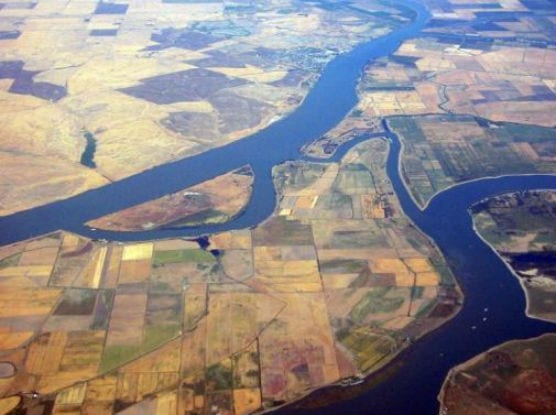The Department of Water Resources today approved the Delta Conveyance Project, a modernization of the infrastructure system that delivers water to millions of Californians.
DWR has certified the Environmental Impact Report and completed an extensive environmental review. DWR selected the “Bethany Reservoir Alignment” for further engineering, design and permitting.
With the state expected to lose 10% of its water supply by 2040 due to hotter and drier conditions, the Delta Conveyance Project is a key part of the California’s Water Resiliency Portfolio and Governor Newsom’s Water Supply Strategy. The project will modernize the state’s water infrastructure to:
-Capture and move more water during wet seasons to better endure dry seasons,
-Minimize future losses from climate-driven weather extremes,
-Protect against earthquakes disrupting water supplies,
-Continue meeting regulatory water quality and fishery requirements, and add new operating rules for further fishery protections,
-Include a Community Benefits Program to ensure local communities get the means and resources to achieve tangible and lasting benefits.
Extreme weather whiplash driven by climate change will result in more intense swings between droughts and floods, intensely straining California’s 60-year-old State Water Project infrastructure. During January’s atmospheric rivers, the Delta Conveyance Project could’ve captured enough water for 2.3 million peoples’ yearly usage.

The environmental review included a 142-day public comment period in which DWR received more than 700 letters and 7,000 individual comments. Outreach began in 2020 and has included a multitude of webinars, workshops, briefings, multi-language informational materials, email updates, videos, animations, tabling at local events, and a comprehensive Delta survey. The Final EIR responds to all substantive comments.
“Today marks another significant milestone in our efforts to modernize state water infrastructure and adapt to the challenges of changing precipitation patterns,” said Karla Nemeth, Director of the California Department of Water Resources. “As our recent white paper The Economy of the State Water Project shows, the State Water Project is one of the most affordable sources of water in California, and we need to help local water agencies in protecting both reliability and affordability for their ratepayers.”
In certifying the EIR and approving the project, DWR has determined the environmental review complies with the California Environmental Quality Act (CEQA), and the Final EIR reflects public input and DWR’s independent judgment and analysis. DWR has also:
-Adopted Findings of Fact and Statement of Overriding Considerations, identifying which mitigation measures are feasible and therefore must be included in the project approval to address potentially significant environmental impacts
-Adopted a Mitigation, Monitoring and Reporting Program to create a tracking program for all mitigation that is identified in the findings and included as part of project approval
-Issued Notice of Determination
-Issued Decisions Regarding the Delta Conveyance Project
“The environmental review process has been thorough and provided us with opportunities to work with the community to minimize potential impacts,” said Carrie Buckman, the project’s Environmental Program Manager. “We are now poised to take the next steps in engineering, design and permitting, and further developing a comprehensive Community Benefits Program.”
An EIR is an important document that evaluates and discloses to public agency decision makers, federal, state and local interested agencies, and the public the potential environmental impacts of a proposed project and alternatives, and identifies feasible mitigation measures to avoid, minimize, or otherwise offset potentially significant impacts.
As a part of project development, DWR made a significant and concerted effort to address local Delta concerns related to the effects of the project on the people of the Delta, Tribes, and disadvantaged members of historic and legacy communities. These efforts helped to avoid and minimize effects on noise, air quality, traffic, power, aesthetics, boating, and land use, among others.
“We made several notable design refinements specifically to avoid or minimize local construction impacts,” said Graham Bradner, Executive Director of the Delta Conveyance Design and Construction Authority, the agency responsible for engineering and design work, and eventually project construction. “We reduced the number of tunnel shafts, chose state-of-the-art fish screens to improve performance and reduce the size of the on-bank structure, and found a way to connect straight to the California Aqueduct. These creative solutions really help to reduce the overall project footprint.”
Now that the environmental review is complete and the project has been approved, DWR will take the next steps to pursue numerous state and federal permits or authorizations, including those required by the State Water Resources Control Board, the Delta Stewardship Council, and compliance with state and federal Endangered Species acts. DWR will also continue to develop a Community Benefits Program. The Delta Construction Authority will provide a new cost estimate and a benefit-cost analysis in mid-2024.
There are 17 public water agencies from the Bay Area, Central Valley, Central Coast, and Southern California participating in the project. Their customers are among the 27 million people and 750,000 acres of farmland that rely on the SWP to provide an affordable source of high quality, clean and safe water.
For more information about the project, visit water.ca.gov/deltaconveyance. For more information about permitting, visit deltaconveyanceproject.com.
Like this:
Like Loading...
Related





 Tweet This
Tweet This Facebook
Facebook Digg This
Digg This Bookmark
Bookmark Stumble
Stumble RSS
RSS



























REAL NAMES ONLY: All posters must use their real individual or business name. This applies equally to Twitter account holders who use a nickname.
0 Comments
You can be the first one to leave a comment.